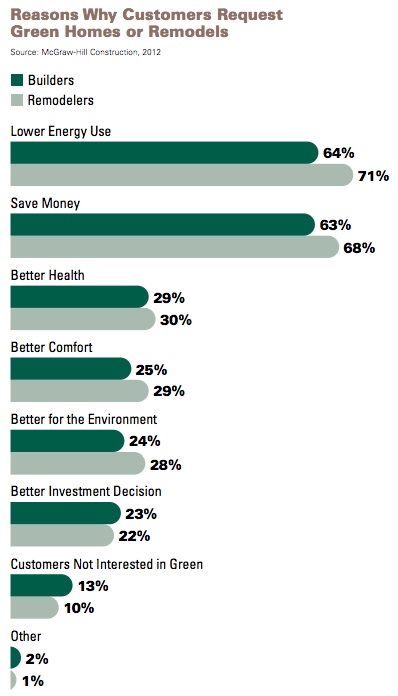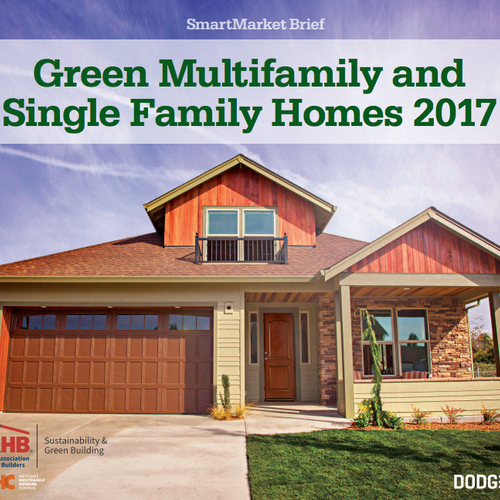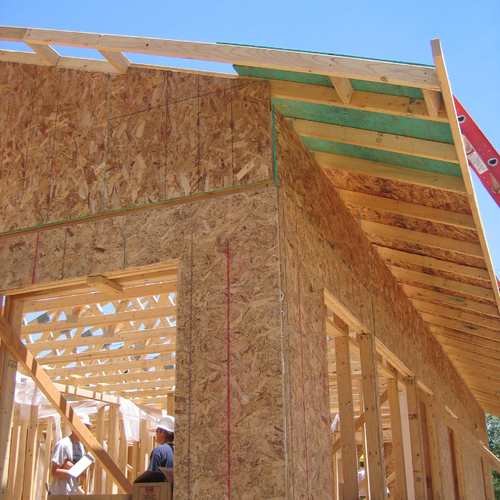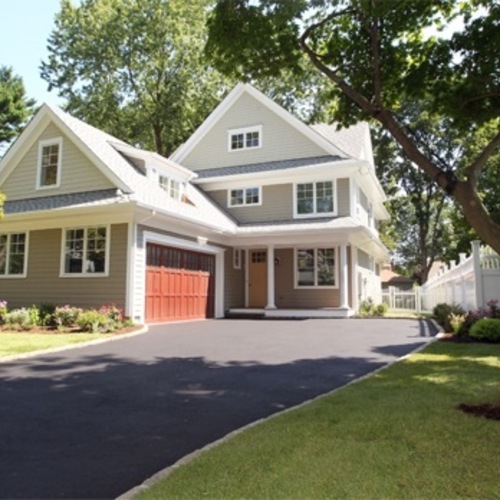Image Credit: McGraw-Hill Construction SmartMarket Report
Image Credit: McGraw-Hill Construction SmartMarket Report General economic conditions being what they are, many prospective customers balk at extra costs associated with green construction, although the SmartMarket study shows that cost is more of a factor for builders than for remodelers.
American consumers are increasingly aware of green construction programs. This increasing awareness is being driven by rising energy costs as well as marketing by builders and building material manufacturers. Moreover, consumers perceive green buildings to be of higher quality than buildings that barely meet code.
Those are some of the findings reported by a recently released study, the McGraw-Hill SmartMarket Report, which focuses on the impact of green practices and materials on home building and remodeling. One highlight from the report that has been emphasized in countless recaps is the expected 29% to 38% rise in green construction’s market share by 2016. Another oft-reported projection from the report: during the same period, the green construction industry’s annual revenue is expected to increase by $114 billion, from the current level of only $17 billion.
Those predictions and a few other findings from the study actually were unveiled back in February, during the International Builders’ Show in Orlando. But the SmartMarket Report contains more interesting findings, including detailed explanations of the market forces at work. (The study can be downloaded for free here.)
For many people, green building is becoming an expectation – a de facto standard that makes barely-to-code construction and remodeling seem inadequate.
Capitalizing on and growing the green market
Tapping into this perception, and encouraging it, tends to be easiest for builders and remodelers who have made green the bulk (60% or more) of their projects, the study’s authors say. For builders hoping to catch the green wave and market it to their advantage, the time to adopt green practices is now rather than five years from now. If SmartMarket predictions hold, that’s when about 33% of builders will already be well positioned in the market.
The study – based on responses from 416 builders, developers, and remodelers surveyed during the fourth quarter of 2011 – defines green homes as those that offer superior energy efficiency and a more comfortable and healthier indoor environment than is found in homes that merely meet code. Many of these projects also focus on recycling, materials conservation, and water conservation.
For example, 84% of builders devoted entirely to new construction say energy efficiency has been one of the key features making homes greener than they were two years ago. About 64% cite improved indoor environmental quality, 50% cite material conservation and recycling, and 47% cite water conservation products and practices.
The appraisal issue, and a shift among big builders
The struggling housing market has prompted a significant number of large builders – those who construct 25 or more homes a year – to invest in green building strategies. In 2009, the study shows, green building factored into less than 16% of projects by 67% of builders surveyed. In 2011, that contingent of builders dropped to 49%, and by 2016 it is expected to drop to 18%.
Predictably, overall economic conditions and continued (albeit diminishing) customer resistance to paying premiums for green construction and remodeling ranked as the top two obstacles to green building activity. Next is the failure of appraisers to adequately assign value to green features and improvements – a longstanding issue that ranked a close third on the obstacles list. Seventy-five percent of builders and 67% of remodelers said lenders and appraisers don’t understand, or fail to properly assess, the long-term value of green construction and improvements.
Energy use dominates customer concerns
Customers of companies focused mainly on green projects tend to cite a relatively wide range of reasons for investing in new construction or upgrades, including the desire for a healthier indoor environment (37%), better comfort (30%), and better overall investment (29%). But lowering energy use (cited by 64% of builders’ customers and 71% of remodelers’ customers) is by far the biggest motivator, as is saving money, which ranked about the same in the survey.
Improving energy efficiency topped the list of key green practices: it was cited as the top priority by 97% of builders and 96% of remodelers. No other practice came even close to that priority level. The use of durable materials, which placed second on the list, was cited by 49% or builders and 58% of remodelers.
One point made near the end of the report is that government incentive programs have helped make the installation of energy-efficient appliances and properly sized and more-efficient HVAC systems top priorities when addressing overall building performance. Installing extra insulation and high-performance windows ranked fourth and fifth on the list, respectively, although both were cited by at least 70% of remodelers and builders as being among their top products and practices. Those priorities could shift, of course, as subsidy programs expire.
Weekly Newsletter
Get building science and energy efficiency advice, plus special offers, in your inbox.
















0 Comments
Log in or create an account to post a comment.
Sign up Log in